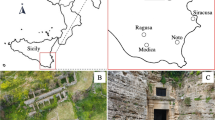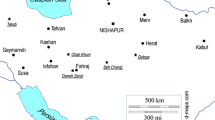Abstract
Correct identification of pigments and all accompanying phases found in colour layers of historical paintings are relevant for searching their origin and pigment preparation pathways and for specification of their further degradation processes. We successfully applied the analytical route combining non-destructive in situ X-ray fluorescence analyses with subsequent laboratory investigation of micro-samples by optical microscopy, scanning electron microscopy/energy-dispersive spectroscopy and X-ray powder micro-diffraction (micro-XRD) to obtain efficiently all the data relevant for mineralogical interpretations of the copper pigments origin. Cu salts (carbonates, chlorides, sulphates, etc.) used as pigments exist in a range of polymorphs with similar or identical composition. The efficiency of the micro-XRD for direct identification of such crystal phases present in micro-samples of colour layers was demonstrated in the presented paper. A new, until now unpublished, type of copper pigment—cumengeite, Pb21Cu20Cl42(OH)40—used as a blue pigment on a sacral wall painting in the Czech Republic was found by means of micro-XRD. Furthermore, azurite, malachite, paratacamite, atacamite and posnjakite were identified in fragments of colour layers of selected Gothic wall paintings. We found Cu–Zn arsenates indicating the natural origin of azurite and malachite; artificial malachite was distinguishable according to its typical spherulitic crystals. The corrosion of blue azurite to green basic Cu chloride was clearly evidenced on some places exposed to the action of salts and moisture—in a good agreement with the results of laboratory experiments, which also show that oxalic acid accelerates the corrosion of Cu pigments.

In situ XRF measurement of Gothic murals in the Benedictine Monastery in Sazava—here The Joseph’s Doubt scene in the capitular hall









Similar content being viewed by others
References
Hradil D, Hradilová J, Hřebíčková B (2001) Clay minerals in pigments of medieval and baroque paintings. Geol Carpath 53:123–126
Aze S, Vallet JM, Baronnet A, Grauby O (2006) The fading of red lead pigment in wall paintings: tracking the physico-chemical transformation by means of complementary micro-analysis techniques. Eur J Mineral 18:835–843
Rasmussen SE, Grundvig S, Friedrich WI (2004) Composition of pigments of Santorini frescoes: the Rietveld method as an aid in qualitative phase analysis. Powder Diffr 19(2):145–148
Šímová V, Bezdička P, Hradilová J, Hradil D, Grygar T (2005) X-ray powder microdiffraction for routine analysis of paintings. Powder Diffr 20(3):224–229
Švarcová S, Kotulanová E, Bezdička P (2008) Use of powder X-ray microdiffraction for mineralogical analysis of colour layer. Technologia Artis 6:223–230
Wang PC, Cargill GS, Noyan IC, Hu CK (1998) Electromigration-induced stress in aluminium conductor lines measured by X-ray microdiffraction. Appl Phys Lett 72:1296–1298
Doryhée E, Anne M, Bardiès I, Hodeau JL, Martinetto P, Rondot S, Salomon J, Vaughan GBM, Walter P (2005) Non-destructive synchrotron X-ray diffraction mapping of a Roman painting. Appl Phys A 81:663–667
Salvadó N, Pradell T, Pantos E, Papiz MZ, Molera J, Seco M, Vendrell-Saz M (2002) Identification of copper-based green pigments in Jaume Huguet’s Gothic altarpieces by Fourier transform infrared microspectroscopy and synchrotron radiation X-ray diffraction. J Synchrotron Rad. 9:215–222
Hradil D, Grygar T, Hradilová J, Bezdička P, Grünwaldová V, Fogaš I, Miliani C (2007) Microanalytical identification of Pb–Sb–Sn yellow pigment in historical European paintings and its differentiation from lead tin and Naples yellow. J Cult Herit 8:377–386
Hradil D, Hradilová J, Bezdička P, Švarcová S (2008) Provenance study of Gothic paintings from North-East Slovakia by hand-held x-ray fluorescence, microscopy and x-ray microdiffraction. X-ray Spectrom 37:376–382
Kotulanová E, Bezdička P, Hradil D, Hradilová J, Švarcová S, Grygar T (2009) Degradation of lead-based pigments by salt solutions. J Cult Herit 10:367–378
Benedetti D, Valleti S, Bontempi E, Piccioli C, Depero LE (2004) Study of ancient mortars from the Roman Villa of Pollio fellice in Sorrento (Naples). Appl Phys A 79:314–345
Eastaugh E, Walsh V, Chaplin T, Siddal R (2004) The pigment compendium—A. Dictionary of historical pigments. Elsevier, Amsterdam
Gettens RJ, West Fitzhugh E (1993) In: Roy A (ed) Artists’ pigments—a handbook of their history and characteristics vol. 2, 2nd edn. Oxford University Press, Oxford
Scott DA (2002) Copper and bronze in art—corrosion, colorants, conservation. Getty, Los Angeles
Naumova MM, Pisareva SA, Nechiporenko GO (1990) Green copper pigments of old Russian frescoes. Stud Conserv 35:81–88
Bauer J, Novák A (1993) Artificial copper pigments in wall paintings. Technologia Artis 3:153–158
Dei L, Ahle A, Baglioni P, Dini D, Ferroni E (1998) Green degradation products of azurite in wall paintings: identification and conservation treatment. Stud Conserv 43:80–88
Bersani D, Antonioli G, Lottici PP, Casoli A (2003) Raman microspectrometric investigation of wall paintings in S. Giovanni Evangelista Abbey in Parma: a comparison between two artists of the 16th century. Spectrochim Acta Part A 59:2409–2417
Vandenbeele P, Lambert K, Matthys S, Schudel W, Bergmans A, Moens L (2005) In situ analysis of mediaeval wall paintings: a challenge for mobile Raman spectroscopy. Anal Bioanal Chem 383:707–712
Pérez-Alonso M, Castro K, Madariaga JM (2006) Investigation of degradation mechanisms by portable Raman spectroscopy and thermodynamic speciation: the wall painting of Santa María de Lemoniz (Basque Country, North of Spain). Anal Chim Acta 571:121–128
Bordignon F, Postorino P, Dore P, Tabasso ML (2008) The formation of metal oxalates in the painted layers of a medieval polychrome on stone, as revealed by micro-Raman spectroscopy. Stud Conserv 53:158–169
Pérez-Rrodríguez JL, Maqueda C, Jiménez de Haro MC, Rodríguez-Rubio P (1998) Effect of pollution on polychromed ceramic statues. Atmosheric Environ 6:993–998
Castro K, Sarmiento A, Maguregui M, Martínez-Arkarazo I, Etxebarria N, Anguo M, Barrutia MU, González-Cembellín JM, Madariaga JM (2008) Multianalytical approach to the analysis of English polychromed alabaster sculptures: μRaman, μEDXRF, and FTIR spectroscopies. Anal Bioanal Chem 392:755–763
Hřebíčková BA (2006) Recepty starých mistrů aneb malířské postupy středověku. Computer Press, Brno
Nevin A, Loring Melia J, Osticioli I, Gautier G, Colombini MP (2008) The identification of copper oxalates in a 16th century Cypriot exterior wall paintings using micro FTIR, micro Raman spectroscopy and gas chromatography-mass spectrometry. J Cult Herit 9:154–161
Mendes N, Lofrumento C, Migliori A, Castellucci EM (2008) Micro-Raman and particle-induced X-ray emission spectroscopy for the study of pigments and degradation products present in 17th century coloured maps. J Raman Spectrosc 39:289–294
Castro K, Sarmiento A, Martínez-Arkarazo I, Madariaga JM, Ferníndez LA (2008) Green copper pigments biodegradation in cultural heritage: from malachite to moolooite, thermodynamic modeling, X-ray fluorescence, and Raman evidence. Anal Chem 80:4103–4110
Krekel C, Polborn K (2003) Lime blue—a mediaeval pigment for wall paintings? Stud Conserv 48:171–182
Všetečková Z (2005) In: Foltýn D (ed) Historia Monastica I. Filosofia, Praha
He F, Vanespen TJ (1991) General approach for quantitative energy dispersive X-ray fluorescence analysis based on fundamental parameters. Anal Chem 63(20):2237–2244
JCPDS PDF-2 database, International Centre for Diffraction Data, Newtown Square, PA, U.S.A. release 54, 2004.
ICSD database FIZ Karlsruhe, Germany, release 2008/2, 2008
Kuckova S, Hynek R, Kodicek M (2007) Identification of proteinaceous binders used in artworks by MALDI-TOFF mass spectrometry. Anal Bioanal Chem 388:201–206
Schweppe H, Roosen-Runge H (1986) In: Feller E (ed) Artists’ pigments—a handbook of their history and characteristics vol. 1. Cambridge University Press, Cambridge
Hawthorne FC, Goat LA (1986) The crystal-structure and chemical-composition of cumengeite. Mineral Mag 50:157–162
Acknowledgements
The authors thank restorers Renáta Novotná Zemanová and Pavel Coufal for providing samples and versatile cooperation and Štěpánka Kučková from the Institute of Chemical Technology in Prague for the analyses by MALDI-TOF MS method. This work was supported by the project of the Czech Science Foundation no. 203/07/1324 and by research intentions AV0Z40320502 (Institute of Inorganic Chemistry of the ASCR, v.v.i.) and MSM 6046144603 (Academy of Fine Arts in Prague).
Author information
Authors and Affiliations
Corresponding author
Additional information
This work was originally presented at the TECHNART 2009—Non-destructive and Microanalytical Techniques in Art and Cultural Heritage, Athens, 27 –30 April 2009
Rights and permissions
About this article
Cite this article
Švarcová, S., Hradil, D., Hradilová, J. et al. Micro-analytical evidence of origin and degradation of copper pigments found in Bohemian Gothic murals. Anal Bioanal Chem 395, 2037–2050 (2009). https://doi.org/10.1007/s00216-009-3144-7
Received:
Revised:
Accepted:
Published:
Issue Date:
DOI: https://doi.org/10.1007/s00216-009-3144-7




